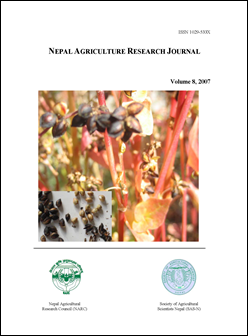On-Farm Variation and Household Diversity of Pigeon Pea Landraces in Kachorwa, Nepal
DOI:
https://doi.org/10.3126/narj.v8i0.11567Keywords:
Household diversity index, on-farm variation, pigeon pea, quant-qualitative traitsAbstract
Farmers value the diversity because of diverse environments both in production and consumption. On-farm morphological variation on pigeon peas (2n = 2x= 22 or 4x, 6x?) was studied at Kachorwa, Bara, Nepal to assess the household categories that have maintained diversity. Household diversity Index (HDI) of 10 different farmer categories was estimated based on Shanon-Weaver method. Eighteen quantitative and qualitative (quant-qualitative) traits were used for on-farm variation and HDI studies. On farm ANOVA was generated on eight quantitative traits. Highest diversity (HDI, 0.265) was maintained by farmer of medium wealth category who grows pigeon pea in upland bund. Pigeon pea grown in khet (low land) bund with Pajawa landrace expressed least diversity (HDI, 0.079). Pigeon pea growing in monoculture was more diverse (HDI, 0.224) for 18 traits than in other production environments. Maximum variation was observed in growth habit followed by seed color pattern. The highest grain yield among the Chanki growers was produced by the farmer of medium wealth category growing pigeon pea in upland bund. Significance variation among farmers in quantitative traits indicates the intra varietal diversity in pigeon pea. Diversity varied with respect to wealth category and production environments. Farmer who has maximum diversity on pigeon pea could able to receive the higher grain yield. Result related to where and who maintain the diversity may be useful for development of on-farm conservation strategy. Possibility of developing good varieties exits using Pajawa and Chanki landraces.
Nepal Agric. Res. J. Vol. 8, 2007, pp. 23-28
Downloads
Downloads
Published
How to Cite
Issue
Section
License
This license allows reusers to copy and distribute the material in any medium or format in unadapted form only, for noncommercial purposes only, and only so long as attribution is given to the creator.




